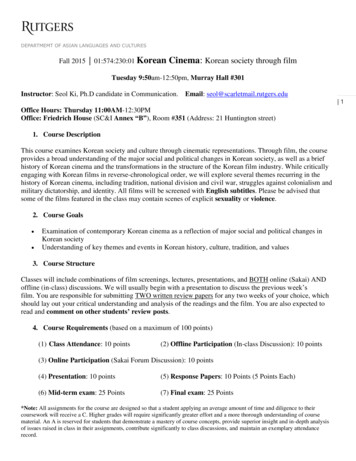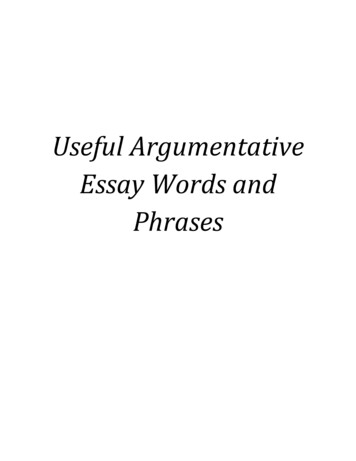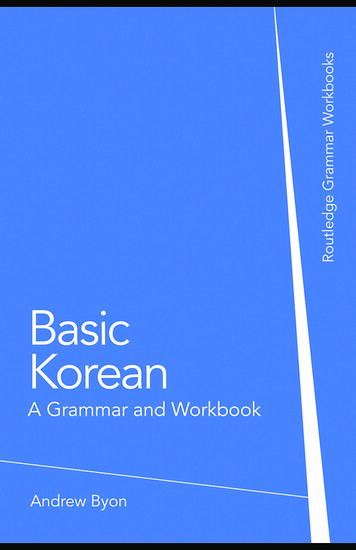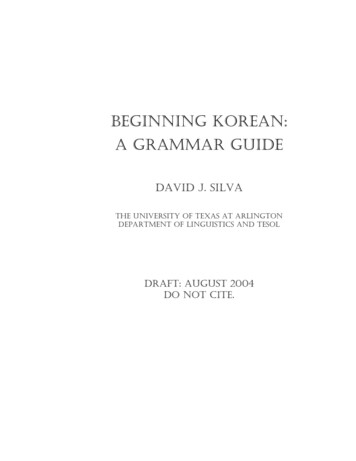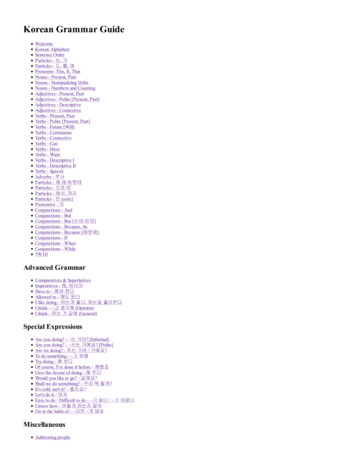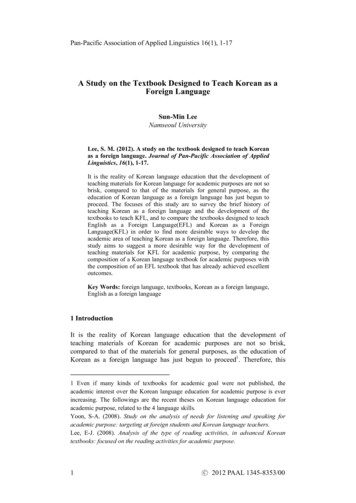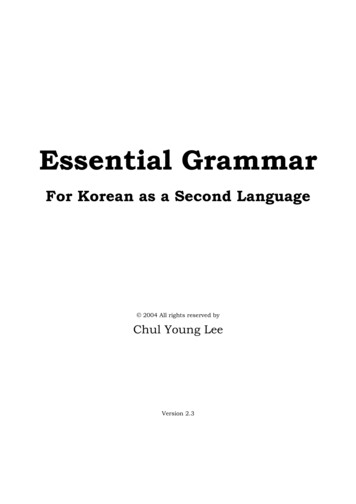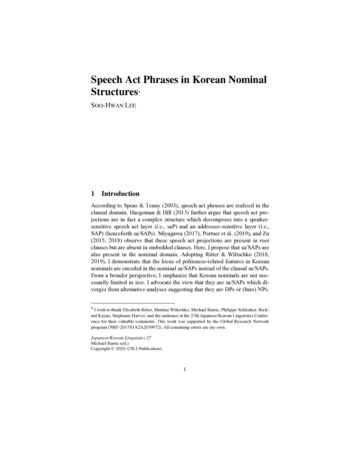
Transcription
Speech Act Phrases in Korean NominalStructures* SOO-HWAN LEE1 IntroductionAccording to Speas & Tenny (2003), speech act phrases are realized in theclausal domain. Haegeman & Hill (2013) further argue that speech act projections are in fact a complex structure which decomposes into a speakersensitive speech act layer (i.e., saP) and an addressee-sensitive layer (i.e.,SAP) (henceforth sa/SAPs). Miyagawa (2017), Portner et al. (2019), and Zu(2015, 2018) observe that these speech act projections are present in rootclauses but are absent in embedded clauses. Here, I propose that sa/SAPs arealso present in the nominal domain. Adopting Ritter & Wiltschko (2018,2019), I demonstrate that the locus of politeness-related features in Koreannominals are encoded in the nominal sa/SAPs instead of the clausal sa/SAPs.From a broader perspective, I emphasize that Korean nominals are not necessarily limited in size. I advocate the view that they are sa/SAPs which diverges from alternative analyses suggesting that they are DPs or (bare) NPs.* I wish to thank Elizabeth Ritter, Martina Wiltschko, Michael Barrie, Philippe Schlenker, Richard Kayne, Stephanie Harves, and the audience at the 27th Japanese/Korean Linguistics Conference for their valuable comments. This work was supported by the Global Research Networkprogram (NRF-2017S1A2A2039972). All remaining errors are my own.Japanese/Korean Linguistics 27Michael Barrie (ed.)Copyright 2020, CSLI Publications.1
2 / SOO-HWAN LEEJust as the fine layers of clauses encode politeness, the fine layers of nominalsencode politeness.The organization of this paper is as follows. Section 2 looks into the previous literature on sa/SAPs. Section 3 discusses the multiple appearances ofsa/SAPs in different parts of the grammar. Section 4 deals with the theoreticalimplications of positing multiple nominal sa/SAPs in Korean. Section 5 concludes.2 Previous literature on speech act structuresAccording to Ross’ (1970) performative analysis, syntactic representationsmake reference to discourse participants (i.e., the speaker and the hearer).Building on this idea, Speas & Tenny (2003) argue that the pragmatic rolesof these participants are built into the syntax. The syntactic projection whichgoverns these pragmatic factors is referred to as the Speech Act Phrase. Adding precision to this analysis, Haegeman & Hill (2013) claim that there are infact two separate tiers of representing speech acts. One is for the speaker (i.e.,saP) and the other is for the hearer (i.e., SAP):(1)saPSpeaker saSAPHearer SA According to Haegeman & Hill (2013), saP/SAP resembles the shell structureof vP/VP. By assuming Larsons’ (1988) way of constructing vP/VPs, we canestablish a parallel shell configuration for saP/SAPs:(2) Parallel shell configurations for saP/SAPs and vP/VPssaP ( higher shell)vP ( higher shell)SAP ( lower shell)VP ( lower shell)In comparison to the single-layered configuration, the two-layered structureof sa/SAPs better captures the distribution of particles, vocatives, and complement clauses under Haegeman & Hill’s (2013) view.It is worth mentioning at this point that the distribution of sa/SAPs issyntactically restricted. To illustrate, they are recognized as a part of syntaxthat appear only in the uppermost domain of a matrix clause. Here, a matrixclause is identical to what Emonds (1969) refers to as the root:
SPEECH ACT PHRASES IN KOREAN NOMINAL STRUCTURES / 3(3) RootA root will mean either the highest S in a tree, an S immediatelydominated by the highest S, or the reported S in direct discourse.(Emonds 1969:6)In the literature, it has been claimed that sa/SAPs give rise to allocutiveagreement.1 Oyharçabal (1993) and Zu (2015) suggest that speech act projections are not embeddable since allocutive agreement is only observed inthe root clause. This leads Zu (2015, 2018) to conclude that sa/SAPs surfaceonly once per a given sentence.Portner et al. (2019) discuss a slightly different take on speech act projections. Despite there being a single locus for discourse information withinthe root clause (i.e., cP in their term), they distinguish utterance-oriented (politeness) markers from content-oriented (politeness) markers. Unlike the former, the latter is able to surface within embedded clauses. Hence, the embeddability of certain discourse-relevant markers is possible under Portner etal.’s (2019) scrutiny.Taking a departure from the analyses mentioned above, Ritter & Wiltschko (2018, 2019) claim that multiple speech act structures can appear evenwithin a single sentence structure. This approach to handling discourse-relevant information, however, does not necessarily imply that it is possible toembed sa/SAPs per se. Instead, Ritter & Wiltschko (2018, 2019) explore thepossibility of encoding speech act projections within the nominal domain. Inlight of Chomsky (1970) and Abney (1987), they draw a parallelism betweenthe clausal and the nominal architectures. Under their analysis, CPs and DPscan both host a discourse-sensitive projection, namely the Speech Act Structure:(4) Parallel clausal and nominal structuresSpeech Act StructureSpeech Act StructureCPDP(Ritter & Wiltschko 2019:718)In (4), a Speech Act Structure is layered above the DP similar to how it islayered above the CP. According to Ritter & Wiltschko (2019) (henceforthR&W), the nominal Speech Act Structure has the function of naming (via1 We come back to the notion of allocutive agreement in section 3.3.
4 / SOO-HWAN LEEproper names), describing (via common noun phrases), and tracking (via pronouns). In the next section, I extend R&W’s discussion on multiple speechact phrases and examine the roles that nominal sa/SAPs undertake in Korean.I will mainly demonstrate the ways in which politeness is realized within agiven sentence structure.3 Multiple sa/SAPsIn this part of the paper, we observe the ways in which politeness marking isrealized in Korean nominal structures. In section 3.1, I adopt Potts’ (2005,2007) concept of expressives and see how they are analyzed in Korean. Insection 3.2, we gain theoretical support on the existence of nominal sa/SAPs.Here, I mainly examine the feature geometry of Referring Expressions(henceforth REs) discussed in Harley & Ritter (2002). In section 3.3, I collectempirical evidence showing politeness mismatches between and among sentence-internal nominals.3.1 Politeness marking in nominalsR&W argue that speech act structures stacked above DPs carry the role ofnaming, describing, and tracking. In addition to R&W’s analysis, I posit thata nominal sa/SAP is the locus for politeness in Korean nPs.2 This is well inline with the view that there is a strong connection between the nominal andthe clausal domain. That is, a Korean nominal on its own has the potential ofconveying politeness which is similar to what a clause (e.g., a verbal predicate with the honorific marker -si) is capable of doing. Consider the followingexamples which are different varieties of Korean first person pronouns:3(5) a. nay-ka1SG-NOM‘I’b. cey-ka1SG.POL-NOM‘I’ (Polite).c. wuli-ka1PL-NOM‘We’d. cehuy-ka1PL.POL-NOM‘We’ (Polite)According to Potts (2005, 2007), expressives such as epithets, quotations, andhonorifics convey conventional implicature relevant to social relation. Basedon this assumption, Lee & Kim (2018) argue that expressives such as ce(y)2 I refrain from asserting a DP for every noun in Korean (see section 4). Instead, I use nPs whichencompass the role of NPs (see Kramer 2015 for further discussion on nPs and Ö Ps).3 The following abbreviations are used in this paper: ABS absolutive; ACC accusative; AUX auxiliary; C complementizer; D declarative; ERG ergative; FORM formal; GEN genitive;NOM nominative; NOMLZ nominalizer; PL plural; POL polite; PRF perfect; PST past;SG singular; Q interrogative.
SPEECH ACT PHRASES IN KOREAN NOMINAL STRUCTURES / 5in (5b) and cehuy in (5d) bear a conventional implicature relevant to politeness (i.e., The speaker is socially inferior to or distant from the addressee).This suggests that the morphological alternations of na ce and wuli cehuyare conditioned by the interaction between the participants of conversation.The same facts hold for pronoun-noun constructions (PNCs) (see Choi (2014)and Höhn (2017) for an extensive discussion on PNCs):(6) a. wuli hayngpokhanenehakca-tul-i1PL happylinguist-PL-NOM‘We happy linguists’b. cehuy hayngpokhan enehakca-tul-i1PL.POL happylinguist-PL-NOM‘We happy linguists’ (Polite)The difference between (6a) and (6b) boils down to whether the conventionalimplicature of politeness is triggered by the selection of pronouns (e.g.,wuli cehuy). In the next subsection, we discuss a theoretical aspect of pronouns which works in favor of the conjecture that speech act structures existwithin the nominal architecture.3.2 Feature geometry & sa/SAPsAccording to Harley & Ritter’s (2002) privative morphological feature geometry, a fully specified RE consists of a Participant node (i.e., PART) andan Individuation node (i.e., INDIV). Here, PART dominates the speaker nodeas well as the addressee node which is of great relevance to our discussion.For one, PART and sa/SAP both consolidate a well-defined interaction between the speaker and the hearer. Also, the idea that PART is dominated byRE is compatible with the notion that an sa/SAP resides within a noun phrase.To clarify, both Harley & Ritter’s and R&W’s analyses rely on a ‘controltower’, be it PART or sa/SAP, that essentially feeds participant informationto the nominal domain as a whole:(7)« REPARTSpeaker Addressee saPSpeakersaSAPHearerSA Evidence from feature geometry (Harley & Ritter 2002) coupled with theexplicit analogy drawn between the nominal and the clausal spine (Chomsky1970 and Abney 1987) support the view that sa/SAPs are a part of the noun
6 / SOO-HWAN LEEphrase. In the next subsection, we direct our attention to some of the structuraldiscrepancies related to politeness marking and observe how the realizationof multiple sa/SAPs effectively account for these puzzling facts.3.3 A mismatch in politeness markingMultiple appearances of sa/SAPs (i.e., one in the nominal domain and theother in the clausal domain) help account for some of the unsettled issuesrelevant to politeness (e.g., honorification) marking in Korean. To be morespecific, positing more than one sa/SAP allows us to do away with whatseemingly looks like optional agreement. It is assumed in the literature thathonorific agreement is a variety of allocutive agreement (Miyagawa 2012,2017). Before investigating honorifics and politeness in detail, let us brieflytouch on the concept of allocutive agreement. Oyharçabal (1993) uses Basqueto demonstrate allocutive agreement.4 In Basque, there is a competition between ‘allocutive’ and ‘plain’ 2nd person agreement:(8) a. Petteklan egin dizüPeter.ERGworked AUX-3SG.ERG.FORM‘Peter worked.’ (To someone higher in status, formal)b. Lan .) worked.’(Basque, Oyharçabal 1993)In (8a), Pettek and dizü undergo allocutive agreement. As a result, a sense offormality is conveyed. In contrast, 2nd person agreement takes priority overallocutive agreement in (8b) and only the 2nd person agreement is manifested.Hence, formality does not result.Miyagawa (2017) extends Oyharçabal’s (1993) analysis and argues thatJapanese politeness (e.g., honorification) marking is an instance of allocutiveagreement. While this analysis may be on the right track for Japanese, weought to be careful about treating all politeness markings as outcomes of allocutive agreement. Consider the following data in Korean which on the surface appears to be an instance of Agree (Chomsky 2000, 2001):(9) OL-PST-D‘Grandmother came.’ (Polite)4 For dialectical variations in Basque and a cross-linguistic analysis on allocutive agreement,refer to Zu (2015, 2018).
SPEECH ACT PHRASES IN KOREAN NOMINAL STRUCTURES / 7In (9), POL appears both on the nominal and the clausal domain. One is realized as the nominative Case marker -kkeyse and the other is realized as -si inthe verbal predicate. The given example could in fact be analyzed as agreement. However, this is by no means the only way that politeness markingworks in Korean. Consider the following data:(10) halmeni-kao-si-ess-tagrandmother-NOM come-POL-PST-D‘Grandmother came.’ (Polite)Note that the politeness marking in (10) is introduced only in the verbal morphology. An obvious question arises as to what the absence of a nominal politeness marker indicates. Here, I emphasize that syntactic agreement alonecannot provide an adequate solution. To add further complication to the story,different degrees of politeness are conveyed in (9) and (10). That is, (9) delivers a strong sense of formality whereas (10) delivers a weak sense of formality. This observation is not surprising given that politeness marking isdoubly encoded in the former whereas it is not in the latter. If politenessmarking in Korean were indeed an instance of Agree, the discrepancy recognized between (9) and (10) cannot be readily accounted for. In fact, there aremany more examples displaying similar gradience. Make particular note ofthe morphological alternation between wuli and cehuy shown below:5(11) a. wuli-kawa-ss-eyo1PL-NOMcome-PST-POL‘We came.’ [Politeness: nP (X), CP ( )]b. cehuy-kawa-ss-eyo1PL.POL-NOM come-PST-POL‘We came.’ [Politeness: nP ( ), CP ( )](11a) encodes a single politeness marker which is realized in the clausal domain (i.e., -yo). On the other hand, (11b) carries multiple politeness markers:one in the nominal domain (i.e., cehuy) and the other in the clausal domain(i.e., -yo) (see Yim 2012 for a discussion on the multiple realizations of -yowithin a clause). The multiple occurrences of POL in (11b) give rise to anelevated sense of formality when compared to the appearance of a single POL5 Along with many others, Lee & Ki
SPEECH ACT PHRASES IN KOREAN NOMINAL STRUCTURES / 5 in (5b) and cehuy in (5d) bear a conventional implicature relevant to polite- ness (i.e., The speaker is socially inferior to or distant from the addressee). This suggests that the morphological alternations of na ce and wuli cehuy are conditioned by the interaction between the participants of conversation.

